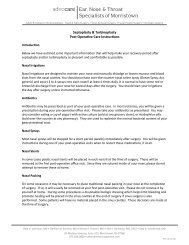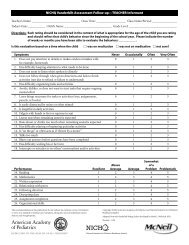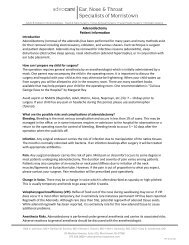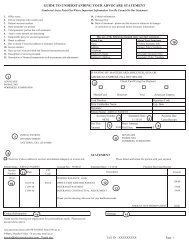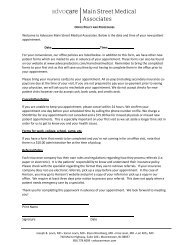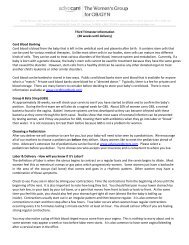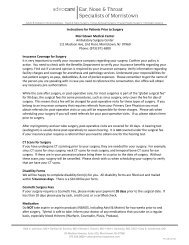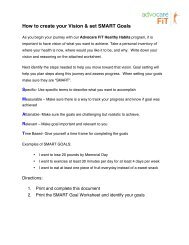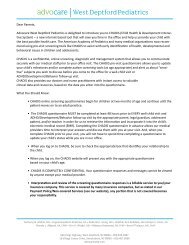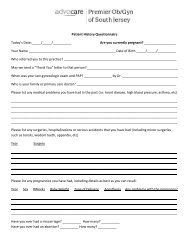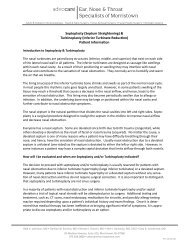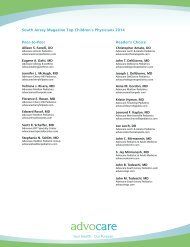You and Your Baby Booklet - Advocare
You and Your Baby Booklet - Advocare
You and Your Baby Booklet - Advocare
- No tags were found...
You also want an ePaper? Increase the reach of your titles
YUMPU automatically turns print PDFs into web optimized ePapers that Google loves.
John M. Tedeschi, MD, FAAPRey Velasco, MD, FAAPJohn B. Tedeschi, MD, FAAPParisa Razi, MD, FAAPMelissa S. Chase, DO, FAAPJulie C. Ayres, MD, FAAPJason S. Weber, MD, FAAPCarolyn H. Weber, MD, FAAPCyriac George, DO, FAAPPete Georgelos, MD, FAAPPuneet Tung, DO, FAAP<strong>You</strong> <strong>and</strong> <strong>You</strong>r <strong>Baby</strong>
Save Time!Please visit the Forms sections ofour website to print <strong>and</strong> completethe New Patient Forms needed foryour baby’s first visit.advocaresjp.com
NEWBORN INSTRUCTIONSCongratulations on your new baby! These instructions are designed as aguide to help you care for your infant. <strong>You</strong>r child is an individual from theday he* is born. It is important to relax <strong>and</strong> enjoy your baby; a relaxedmother <strong>and</strong> father will help an infant to be relaxed.Sometimes new parents are somewhat unsure of themselves. However, aslong as your baby is loved, well fed, warm, <strong>and</strong> comfortable, you need notworry that you are less than expert. Trust yourself, <strong>and</strong> don’t take tooseriously all the advice of well-meaning friends <strong>and</strong> relatives.<strong>You</strong>r baby will do many of the things that all babies do. All babies sneeze,yawn, belch, have hiccups, pass gas, cough, <strong>and</strong> cry. Sneezing is theonly way your baby can clean his nose. Hiccups are little spasms of thebaby’s stomach muscles. Crying is your baby’s way of saying, “I’m wet, I’mthirsty, I want to turn over, I’m too hot, I’m too cold, I have a stomach ache,I’m bored, or I’m hungry”. <strong>You</strong> will gradually learn to know what your babymeans when he or she cries.Almost all babies have fussy periods. These may occur regularly, perhapsin the late afternoon or evening. This is not colic, but a normal occurrence ininfants.All babies are different. Please don’t compare your baby with other babies.Babies may be taken outside. Avoid overcrowded places for the first monthif possible. Do not overdress infants for trips outside; they should bedressed in accordance with the weather. Do not use sunblock, protect themfrom the sun, dress them as you would dress yourself.Please call the office at 424-6050 any week day shortly after you comehome from the hospital in order to make an appointment for your baby’s firstcheck-up. The baby should be checked by us 3 to 4 days of age unless weinstructed you differently.* For convenience the words “he, his, him” will be used throughout the booklet to designate both sexes.4
GENERAL INFANT CAREBathingHave everything set up before the bath so you don’t have to leave the babyunattended. It’s good to have a fairly regular time for bathing your baby.The room should be warm, with no drafts. Keep bathing supplies together tosave yourself steps. Until the navel (<strong>and</strong> circumcision, if your baby had thisprocedure, is healed) wash your baby by sponging. After it has healed, youcan use a tub or bathinette.* If dry skin is noted bathe every other to three days.Face: Wash with plain warm water <strong>and</strong> soft cloth <strong>and</strong> no soap.Eyes: To clean eyes, use cotton dipped in cool water until one month.Wipe from bridge of nose towards ears.Nose <strong>and</strong> Ears: Cleanse outer areas only with a moist washcloth orcotton ball. Do not attempt to cleanse the inside of either nose or ears witha Q-tip.Head: <strong>You</strong>r baby’s head should be lathered gently with mild shampoo.Work from front to back to keep suds out of your baby’s eyes. Cleancarefully over the softspots on your baby’s head. Washing the head twiceweekly is usually sufficient. If you notice a greasy scaling (cradle cap), callthe office.Body: Use a mild soap (e.g., Dove soap) <strong>and</strong> warm water. Be sure to washin the creases, <strong>and</strong> rinse well.Nails: Use a fingernail clipper for trimming. This may be necessary two orthree times a week in order to keep the baby from scratching himself. Avoidclipping the nails too short. Don’t bite infant nails. It may be easier to doinfant nails while the infant is sleeping. <strong>You</strong> may also use a file.Between Baths: Keep your baby clean between baths. It will help toprevent skin Irritations <strong>and</strong> will keep your baby contented.Navel: Use alcohol no more than three times a day. Keep navel clean <strong>and</strong>dry. A gauze square may be used. Sometimes after the cord falls off theremay be a few drops of blood, but this is no cause for worry. Fold the diaperbelow the cord until it is healed. If an umbilical hernia is present, we willexplain the cause <strong>and</strong> care at your first check-up.Circumcision: With each diaper change place a Vaseline gauze aroundthe circumcision. Continue this until healing takes place <strong>and</strong> the skin coloris normal. At this time, wash it with soap <strong>and</strong> water, just as you wouldanother part of the body. The foreskin on a circumcised penis should beretracted <strong>and</strong> cleansed daily to help prevent adhesions. Girls sometimeswill have a small amount of bleeding from the vaginal orifice after being5
ought home from the hospital. This is no concern <strong>and</strong> represents only theresponse of the infantile uterus to withdrawal of maternal hormones. Thereis no cause for alarm as long as the discharge is of small quantity <strong>and</strong> is notpersistent.Breasts: Both boys <strong>and</strong> girls breast may be enlarged after birth. This isnormal due to a hormonal change in your infant.Sleeping: Babies should be left to sleep on their back only. A firm mattressis best. No pillow should be used in the crib, <strong>and</strong> covers should never betucked in. Cribsides should never be left down. Even a very small infantshould never be left unattended on a regular bed, chair, tabletop, etc. It isamazing how many infants have fallen from a table, bed, dresser or infantseat. Please be careful.Vitamins: <strong>You</strong>r baby will not be started on vitamins at this time. We willdiscuss vitamins with you at your visit. Vitamins with fluoride will bestarted at 6 months.Medication – Some Do’s <strong>and</strong> Don’ts1. Antibiotics should be given on time according to the instructions on thebottle. Ideally antibiotics should be administered one (1) hour before orafter meals. Be sure to administer the antibiotics for the full courseprescribed by the doctor then discard any residual medication.2. Never use a medication that was prescribed for one child on your otherchildren even if they “have the same symptoms” without calling the officefirst.3. It is not necessary to wake your child to give cough medicines; it isnecessary if it is an antibiotic.4. To give a young baby a pill crush the pill <strong>and</strong> put it on a teaspoon with asmall amount of water or juice or mix it with a little applesauce <strong>and</strong> thenoffer it.5. To give ear drops place your child on his side <strong>and</strong> pull the ear down <strong>and</strong>back. Repeat with other ear if directed.6. To administer eye drops, place your child on his back. Pull down thelower eye lid slightly to form a small sac <strong>and</strong> place the drops in the sac.Repeat with the other eye if directed.Clothing: <strong>You</strong>r baby does not required any more, if as much, clothing asan adult, so never overclothe or overcover him. Dress him according tothe temperature. When your baby sleeps, his h<strong>and</strong>s <strong>and</strong> feet may be cool.Some babies are allergic to certain materials, so watch for rashes in clothingcontact areas. All new clothes should be washed <strong>and</strong> thoroughly rinsedbefore wearing. This will help decrease the chance of any skin irritation.Use detergent for babies such as Dreft.6
Visiting the Doctor: Regularly scheduled visits to the doctor’s officeshould be continued, even though your baby appears well. As part of thephysical examination, the baby will be evaluated for growth <strong>and</strong>development. Changes in care <strong>and</strong> feeding may be advised.Immunizations against diseases such as whooping cough, diphtheria,tetanus, polio, measles, mumps <strong>and</strong> rubella will be given at the propertimes. These visits will reassure you about the progress of your baby, <strong>and</strong>your questions <strong>and</strong> problems can be discussed. It is often helpful to haveyour questions written down at the time of your visit. This will relieve anyanxiety <strong>and</strong> frustrations you may have <strong>and</strong> help maintain a satisfactoryemotional atmosphere for your baby.When to Call the Doctor: Sometimes parents have difficulty decidingwhether their baby is sick. Many young babies sneeze, are fussy at times,<strong>and</strong> occasionally spit up. These things are not serious <strong>and</strong> do not requirethe doctor’s attention. Generally, if your baby becomes listless or inactive,will not eat, cries much more than usual, has a rash, vomits repeatedly, orhas almost constant loose, watery stools, it is advisable to consult the office.If you are calling for a sick child, please take the temperature before you call<strong>and</strong> have a pencil <strong>and</strong> paper ready for any instructions that may be given. Itis also helpful to have your pharmacy number on h<strong>and</strong> in case somethingneeds to be ordered. A fever of 100.4º or higher in a baby less than a monthold is an emergency - call.Never debate about calling the office. If you have any questions we will beglad to advise <strong>and</strong> guide you. No question is too petty if it concerns you oryour baby, no matter what time it is.Car Seats: It is a New Jersey State Law that any child under the age of 8years must be securely restrained in a federally approved car seat. Due tosafety concerns with air bags, all children less than the age of 12 should beplaced restrained in the back seat. It is required that any child weighingunder 80 pounds should be in a car seat <strong>and</strong> not just restrained with a seatbelt only. The reasoning behind this is that a car seat will protect the childfrom abdominal injuries better than a seat belt if they were to be in anaccident. Current recommendations are that all infants should face the backof the car until their second birthday. For a booster seat, the child shouldweigh 40 pounds. The center back is the safest place in a car.Any concerns/questions about this issue please ask your doctor.7
FEVERFever should not be feared <strong>and</strong> in itself is a normal body’s response toillness. Do not panic over fever. A child’s normal temperature can fluctuatefrom 97º to 100º throughout the day. A fever is defined as any temperature> 100.4º.Reducing fever adds to the comfort of your baby. One does not have to beaggressive at bringing the temperature down to normal. If any fever occursin an infant of less than three months of age, call the office immediately. Ifan infant is over three months, treat the fever as follows every four (4) hours:Fever itself is not harmful – it is simply a sign that the body is fighting someinfection. Do not give Tylenol to a baby under 3 months old before callingthe office.Acetaminophen (Tylenol or non-aspirin) comes in several br<strong>and</strong>s <strong>and</strong>concentrations. The dosing is different for the different preparations. Pleaseread the package first. Only use the dropper supplied with the package <strong>and</strong>do not use with other medications. Please call our office with any dosingquestions.The Tylenol bottle (non-aspirin) will be marked in ml’s. These medicationsshould be given for fever only – they do nothing for a cold. If fever persistsfor more than 24 hours in an infant older than three months, or any fever isrecorded in an infant under three months call the office.Any infant under the age of 3 months with a temperaturegreater than 100 degrees – call the office.Care of a child with a fever:1. Do not over dress your infant or use excess covers or quilts. This willcause his temperature to rise since there is no where for the heat toescape.2. Encourage cool clear liquids as often as possible. <strong>You</strong> may also usepopsicles, sherbert or cracked ice for the older child.3. When calling the office to report your child’s temperature please informthe Nurse or Doctor which method you use to take it.Taking your child’s temperature: <strong>You</strong>r child should not drink hot or coldliquids several minutes before the temperature is taken.8
By Ear (OTIC)Follow manufacturers’ instructions regarding use. Keep in mind that severalfactors may contribute to an inaccurate reading such as improper fit, earwax, infection, etc. <strong>You</strong> may want to confirm results with the abovemethods.Some notes about your thermometer:1. The only difference between an oral <strong>and</strong> rectal thermometer is the tip– the rectal has a blunt end <strong>and</strong> the oral is slender. The reason for usinga rectal thermometer is to prevent perforation of the rectum whileinserting the thermometer.2. Either a rectal or oral thermometer may be used under the arm.3. Each line on the thermometer represents .2 degrees – for example, thisis read 98.6º.94 96 98 1004. An axillary temperature is best to take when your child is too young tobe trusted with an oral thermometer.5. <strong>You</strong> may start to use an oral thermometer when you feel your child canunderst<strong>and</strong> not to bite it <strong>and</strong> can also hold it in his mouth. Never use iton a child under three years old.6. Do not wash your thermometer in hot water.COMMON INFANT PROBLEMSStuffy Nose: This is common in infancy <strong>and</strong> is usually due to normalmucus. Rarely it may be due to a cold or allergy. The baby will frequentlysneeze or cough to clear his nose. Frequent use of a cool mist vaporizer<strong>and</strong> nasal aspirator is usually very helpful. A solution of ¼ teaspoon of saltin a cup of warm water can be made daily <strong>and</strong> used as nose drops beforeaspiration. Place two drops in one nostril <strong>and</strong> suction <strong>and</strong> then repeat in theother nostril.Spitting Up: This is a very common infant problem. Unless it is of largeamounts there is no need for concern. If your infant is spitting up all of hismilk, or spits up after every feeding call the office.Bowels: The nature <strong>and</strong> frequency of the bowel movements aredetermined to a large extent by the formula or other foods that the babyeats. Some babies normally only have one bowel movement every fewdays, while others have them after every feeding. Both are normal.Consistency is more important than frequency. The stools should not beextremely hard nor very watery. Breast fed babies often have loose stools<strong>and</strong> this is not dangerous. An occasional small amount of mucus in the stool9
is not unusual. Most babies grunt, strain, <strong>and</strong> cry during a bowel passage.This is normal. Yellow, green <strong>and</strong> brown stools are to be expected. As thediet of your baby changes, so too the stool pattern <strong>and</strong> consistency willchange. This is to be expected.Constipation: For true constipation (extremely hard <strong>and</strong> dry stools) giveprune juice to drink (1½ ounces prune juice to 1½ ounces of water) a fewtimes a day.Diarrhea: Diarrhea describes not only frequent stools, but stools whichhave no solid matter in them. Treat early in children over six months withclear liquids. Pedialyte®, an electrolyte water solution can also be given.<strong>You</strong> may continue formula or breast milk if your child wants. As the childfeels up to it, gradually introduce normal healthy foods as this will help himrecover. Stay away from juice or very high fat foods. A rule to remember fordiarrhea in children under six (6) months is, for bloody diarrhea, for diarrheawhich persists for more than two (2) days using the above suggestions, orconcerns regarding dehydration call the office. Watch for signs ofdehydration such as decrease in wet diapers or dry mouth.SKIN PROBLEMSDiaper rash: Mild diaper rashes are best h<strong>and</strong>led by keeping the baby’sbottom DRY <strong>and</strong> well ventilated. If a rash is a problem do not use plasticpants <strong>and</strong> change the diaper frequently (or go without a diaper completely).Use corn starch, A & D ointment, Desitin or Balmex to help fight <strong>and</strong> preventrecurrence of diaper rash. For severe or persistent rash or one that isaccompanied with a fever call the office. Also stop using wipes.Skin rash: Most babies have skin rashes for the first several weeks. Theymay be isolated blotchy areas or widespread rashes. Use of a mild soapwill provide the only necessary care. Heat rash is common in summer <strong>and</strong>winter <strong>and</strong> will occur over the neck, chest, upper back <strong>and</strong> in creases. Avoidtoo warm a room, too heavy clothing <strong>and</strong> treat by keeping the baby clean,cool <strong>and</strong> dry. <strong>You</strong> can also sponge bathe with 2 tablespoons of cornstarchor 1 tablespoon of baking soda in basin of water to aid in clearing the rash.Allergic rash: This is usually manifested over the entire body <strong>and</strong>appears red with irregular blotches. Before starting any treatment you needto find the cause in order to eliminate it. Have you changed clothesdetergents, started using a fabric softener, introduced new food or dressedyour child in a new outfit? If you can determine the cause – stop it. Also youcan add 2 tablespoons of cornstarch or 1 tablespoon of baking soda to abasin of water <strong>and</strong> sponge bathe <strong>and</strong> also use Calamine or Caladryl lotionuntil you see improvement. For severe or persistent rash or oneaccompanied by fever call the office.10
Cradle Cap: Use <strong>Baby</strong> Oil or Selsun Blue Shampoo. Do not be afraid toscrub the soft spot on the scalp gently when shampooing. Cradle cap startshere <strong>and</strong> will spread if not treated early. It is benign, however <strong>and</strong> willrespond to soap <strong>and</strong> water. If it is extensive or persistent please call theoffice for further instructions.Acne of the newborn: This rash is found primarily on the face <strong>and</strong> neck ofinfants under six weeks old. It is a normal occurrence <strong>and</strong> requires no treatmentexcept keeping the area clean <strong>and</strong> dry. Do not apply creams or lotion.This rash resembles adult acne in appearance.Some don’ts in skin care:1. Don’t use oil or greases – they often cause rashes.2. Don’t bathe too often, twice a week is enough. Too frequent bathing willdry the skin.3. Don’t use drying soaps on the baby such as surgical or antibacterialsoaps. A mild soap is recommended.Colic: All babies will experience a fussy/irritable period, sometimes occurringthe same time each day. Babies with colic, however, will have prolongcrying bouts everyday that will last for 3 or more hours <strong>and</strong> they may drawup their legs in some apparent pain. There is no known cause for colic. Itgenerally begins around 2-3 weeks of age <strong>and</strong> can last up to 4 months ofage. It can occur in both breast fed <strong>and</strong> formula fed babies.Here are some remedies that you can try at home:1. Be sure that if you are formula feeding your baby that you are mixing theright concentrations of formula to water. Also be sure that the formula isnot too warm.2. Feed your baby slowly <strong>and</strong> burp frequently. Try burping the baby beforeyou feed too. After you are finished feeding the baby keep him uprightfor about 20 minutes, this allows for easier digestion <strong>and</strong> less spitting up.3. If you are breast feeding avoid foods like milk, caffeine, chocolate,broccoli, <strong>and</strong> other gas producing foods.4. Motion sometimes seems to soothe a colicky infant. <strong>You</strong> can try aninfant swing or a car ride.5. Some infants respond to being swaddled in a blanket or try a “snuggle”front carrier. They like the warm secure feeling of the closeness.6. Pacifiers help to quiet a crying baby. Excess crying leads to theswallowing of air which leads to gas.If the colic becomes severe <strong>and</strong> none of these remedies help, please callthe office.11
At Feeding TimeFEEDINGFeeding is one of your baby’s most pleasant experiences. A baby’s firstfeeling of love for his parents arises primarily from feeding. At feeding time,the baby receives the nourishment from food <strong>and</strong> a feeling of security fromparents’ loving care. The food helps your baby to grow healthy <strong>and</strong> strong.Parental love, generously given, starts your baby in the development of asecure <strong>and</strong> stable personality.Both the baby <strong>and</strong> the person feeding the baby should be comfortable atfeeding time. Choose a chair that is comfortable. This will help you to becalm <strong>and</strong> relaxed as you feed your baby. <strong>You</strong>r baby should be warm <strong>and</strong>dry so that he is comfortable too.Hold you baby in your lap, with his head slightly raised <strong>and</strong> resting in thebend of your elbow. Whether breast-feeding or bottle-feeding, hold yourbaby comfortably close.General Feeding InstructionsBabies should be fed on dem<strong>and</strong> every three to four hours. During the daytimewake the baby after four hours, but at night let the baby sleep as longas he wants to sleep. Babies should not be fed more frequently then everytwo to three hours. Both breast <strong>and</strong> bottle feeding are good ways to feedyour baby. <strong>You</strong> must choose the way which is best for you.SterilizationSterilization is not necessary but cleanliness is. A dishwasher or hot waterwashing is adequate for this. Water from untreated sources (private pumps,etc.) should be boiled before use. Tap water may be used directly from thefaucet if from a city supply from the time you bring your baby home. Bottledwater is unnecessary for infant formula preparation. Public water suppliesare regulated <strong>and</strong> safe for infants with the added bonus of fluoridesupplementation.BurpingBurping your baby helps remove swallowed air. Burp your baby by holdinghim upright over your shoulder <strong>and</strong> gently patting or rubbing the back.Another way is to place your baby face down on your lap, <strong>and</strong> gently rub theback. <strong>You</strong>r baby can also be burped by being held in a sitting position(leaning slightly forward) on your lap, with your h<strong>and</strong> supporting the baby’schest. Don’t be alarmed if your baby spits up a few drops when beingburped.It isn’t always necessary to interrupt a feeding to burp your baby, but alwaysburp your baby after each feeding. If unsuccessful, wait ten minutes <strong>and</strong> tryagain.12
BREAST FEEDINGBreast feeding is a wonderful experience for you <strong>and</strong> your baby, but youshould know that it is not always easy, especially early on. Remember thatit takes a few days for your milk to come in-at first you will make colostrums,which is rich in antibodies to help your baby fight infection. Breast milk isproduced on a “supply <strong>and</strong> dem<strong>and</strong>” basis – this means that in order foryour milk to come in, you should breast feed your baby 8-12 times a day.The more you breast feed, the more milk you make. It is also best not togive your baby a pacifier or a bottle for the first few weeks until breastfeeding is well-established.Many moms worry that their babies are not getting enough milk. <strong>You</strong> shouldlook for the following signs:• Once your milk comes in, you feel engorged before a feeding <strong>and</strong> feelrelieved after a feeding. Many mothers feel a “let-down” sensation.• <strong>You</strong>r baby should be making frequent wet <strong>and</strong> dirty diapers. A rule ofthumb for wet diapers is the number of wet diapers should equal the daysof life until day 3 or 4, when your milk comes in <strong>and</strong> baby should makeabout 4-8 wet diapers a day. Breast fed babies should make frequentstools, at least 4 a day by the 4th day of life.• <strong>You</strong>r baby acts hungry before a feeding (rooting, restless), <strong>and</strong> satisfiedafter.• <strong>You</strong>r baby will lose some weight in the first days after birth but shouldcatch up to birth weight by about 2 weeks. This is why it is important tofollow your baby’s weight closely in the office.If you are using a pump to express breast milk, you should know thatwhatever amount you are able to pump, your baby is most likely gettingmore than that when he nurses. No pump can replicate the let-down thatoccurs when your baby is on your breast.A key to breast feeding success is to make sure you get help when youneed it. There are support groups in the area where you can meet othermoms who are breast feeding. Lactation consultants are experts who canwork with you directly to make sure your baby is nursing well. Lastly, youshould not hesitate to call the office with questions or come in for a weightcheck or visit with one of the doctors if you are worried – we are here tohelp!13
FORMULA FEEDINGFeeding the baby is a simple <strong>and</strong> natural process, <strong>and</strong> you should not feeloverwhelmed by the details of advice given to you about feeding.Seated comfortably <strong>and</strong> holding your baby, hold the bottle so that the neckof the bottle <strong>and</strong> the nipple are always filled with formula. <strong>You</strong>r baby has astrong <strong>and</strong> natural desire to suck. For him, sucking is part of the pleasureof feeding time. Babies will keep sucking on nipples even after they havecollapsed, so take the nipple out of the baby’s mouth occasionally. Thismakes it easier for him to suck, <strong>and</strong> lets him rest a bit.NEVER prop the bottle <strong>and</strong> leave the baby to feed himself. The bottle caneasily slip into the wrong position. Remember, too, the baby needs thesecurity <strong>and</strong> pleasure it gives him to be held at feeding time. It is the timefor him <strong>and</strong> you to relax <strong>and</strong> enjoy each other.The amount of formula your baby takes will vary, from feeding to feeding<strong>and</strong> day to day. Babies have a right not to be hungry sometimes, just as you<strong>and</strong> me, <strong>and</strong> you cannot make a baby want to eat. Please do not feed morethan 26-32 ounces in 24 hours. If you feel more is necessary call the officefor guidelines.Most babies feed fifteen or twenty minutes. <strong>You</strong> will probably find thatsometimes your baby will take all of his bottle, <strong>and</strong> sometimes he will not.This is normal. As your baby grows <strong>and</strong> gains weight, he will need moreformula.The formula which you will be using when you go home will be the same asthat which you have been using in the hospital (Similac). We will tell youabout any changes should they be necessary.After you have fed <strong>and</strong> burped your baby, place him in his bed on his back.Expect a brief period of fussiness before the baby settles down to sleep.If your baby is having any problems with feeding, please call our office forguidance.INTRODUCING SOLID FOODSSOLID FOODSWhen to StartPopular attitude rather than nutritional need has resulted in a trend to introducesold foods too early. Many people believe that giving solid foods willencourage a baby to sleep through the night at an earlier age, will prolongthe time between feedings, or will satisfy appetite better. While one or moreof these beliefs may be true for the occasional baby, early introduction of alarge number of foods is not necessary. Before starting any foods call theoffice or discuss it with us at your next check-up.14
Successful spoon-feeding<strong>You</strong> can start feeding your baby solid foods by giving him small quantitiesat first, then increasing them very gradually. If your baby rejects aparticular food, simply offer that food again several days later. Even withfavorite foods babies should not be encouraged to eat more than they willreadily accept.We suggest introducing only one new food at a time, at intervals of 3 to 5days. <strong>You</strong>r baby may be sensitive to a particular food, <strong>and</strong> allowing severaldays before starting another food gives you time to observe whether he orshe does have a sensitivity.When starting your baby on cereal, you may add water, breast milk, orfortified formula to the dry cereal to make a mixture that is nearly fluid. <strong>You</strong>rbaby may push a good bit of it back out as you feed, because at first youngbabies naturally push out their tongue when a spoon is put in their mouth.Placing this mixture in small amounts near the back of your baby’s tongue willencourage him to swallow it. Try to be patient <strong>and</strong> don’t force the issue. Asyour baby becomes accustomed to the spoon, the amount of cereal <strong>and</strong>other baby foods can be increased. Start with 3 teaspoons 3 times daily <strong>and</strong>work up to 3 tablespoons 3 times a day.DAY 1 DAY 2 DAY 3 DAY 4First solid foods1 tsp. 1 Tbsp. 3 Tbsp. ½ - 1 Jar1. Birth to 4 months of age – Breast milk or formula only for babies in thisage group.2. At 4 months of age baby cereal may be started. Iron fortified dry infantcereals are higher in nutritional value than prepared cereal-fruitcombinations. Cream cereals contain varying amounts of different ironcompounds, not all of which are well absorbed, <strong>and</strong> most adult drycereals also provide less iron than infant cereals.3. After cereals are well accepted you can start Stage 1 foods. Allow 3-4days in between each new food to look for reaction.4. At 12 months of age whole milk can be started with a Doctor’s permission.Whole milk is to be given until the age of 2 years then it shouldbe changed to 2% lowfat.Vegetable <strong>and</strong> meat combination dinners can contribute variety to yourbaby’s diet but offer no nutritional advantage over similar non-combinationproducts. Desserts <strong>and</strong> puddings with high sugar contents should be givensparingly, if at all.15
So called “finger foods” such as cheerios <strong>and</strong> puffs <strong>and</strong> smaller pieces ofbanana may be introduced between 6 <strong>and</strong> 10 months. By 9 months, piecesof cheese <strong>and</strong> soft fruits may be given, however, small pieces of hard food,such as raw carrots <strong>and</strong> peanuts, should be avoided until your baby is mucholder. Grapes are healthy finger foods but should be sliced in half or smallerto avoid choking hazards.The baby who is offered finger foods will become accustomed to variousfood textures <strong>and</strong> learn self-feeding skills. Mastering the use of a spoon <strong>and</strong>cup are major developmental accomplishments, <strong>and</strong> manipulation of fingerfoods is a step toward accomplishing these goals.AS YOUR BABY BECOMES A TODDLERFoods: Between the ages of one to two, many children show little interestin eating. They would rather play. Not only do children’s appetites decreaseat this time, but they do not want their playing to be interrupted just becauseit is mealtime. This period will pass. <strong>You</strong>r child will eat when he is ready<strong>and</strong> will not starve. Remember fluid intakes can be quite filling thus becareful to avoid a large fluid intake prior to mealtime.Toddlers will probably begin to show definite likes <strong>and</strong> dislikes for food. Itis your job to provide your child with the healthy foods you would like him toeat, <strong>and</strong> it is his job to choose whether or not to eat them. Most toddlers liketo try to feed themselves. They can usually manage to get spoonfuls of foodinto their mouths with little spilling <strong>and</strong> can drink from a cup quite well, butthey may still need some help from you. Use of spoon, cup <strong>and</strong> fork shouldbe encouraged, but the fork should have blunt ends.Convenience, cost, <strong>and</strong> acceptance by your toddler will help determinewhen you substitute table foods for baby foods. At first, table foods can bechopped up in a st<strong>and</strong>ard food mill or blender or in a baby food grinder. Ifyou prepare your baby’s foods from table foods, you should remove thebaby’s portion before you add salt or seasoning. Continuing a balancedvariety of foods, including cereals that are iron-fortified, is the best way toensure that your baby’s diet is nutritionally sound.Toilet training: It is recommended that you do not start training yourtoddler until he is 2 years old. When your child is ready, set him on the toiletfor a few minutes at the time a bowel movement usually occurs. Toilettraining can be difficult or easy – don’t become overwhelmed with it <strong>and</strong>remember, accidents will happen. If you are having a particular problemwith toilet training your toddler, please call the office for more advice specificto your child.16
Period of tooth developmentTEETH<strong>You</strong>r child’s teeth started to form beneath the gums before birth. The firstprimary (baby) tooth that erupts through the gum is usually a lower centralincisor. It begins to show at about 6 to 10 months of age. All primary teeth(20 in all) are usually through the gums by about 20 to 31 months of age.When these rather small teeth enter your child’s mouth they are hard, sharp<strong>and</strong> ready to be used. Infants <strong>and</strong> children should not be placed in the cribwith a bottle. Allowing an infant to sleep with a bottle is a well recognizedfactor in promoting tooth decay, also known as “bottle caries”.TeethingWhile your child is teething he may become irritable or drool excessively;both of these are normal. Cool fluids may also help during this time yourbaby may remain irritable until the teeth have erupted. If you are having aspecial problem please call the office.Dental CareTo keep your child’s teeth clean:< 1 year: Wipe tooth/gum surfaces with wet cloth to remove foodparticles.1 – 2 years: Use soft infant toothbrush. <strong>You</strong> may use infant toothpasteas part of daily routine.2 – 3 years: Use toothpaste <strong>and</strong> brush teeth at least twice daily <strong>and</strong>assist your child.> 3 years: Begin a twice yearly visit to a dentist for routine cleaning.Permanent teethThe first of your child’s 32 permanent teeth will appear at around 6 to 7years. These first permanent teeth, called the “6-year-molars” come inbehind the last upper <strong>and</strong> lower primary teeth. Eruption of these molarswill occur even before your child has lost any primary teeth.“Six-year-molars” are very important to the development of the rest of thepermanent teeth. They determine the final arch of the teeth in the jaw. Itis this arch that provides an adequate bite for chewing foods. These firstmolars also provide alignment for upper <strong>and</strong> lower teeth, which in turnaffects the growth of the facial bones that determine the shape of the face.Because these first molars are so important, your dentist will probably wantto check to see if they are growing properly.After the appearance of the 6-year-molars <strong>and</strong> until your child is 12 or 13years old, the primary teeth will be replaced by permanent teeth in aboutthe same order that the primary teeth appeared. Four new molars, calledsecond molars, erupt at 11 to 13 years of age; the last four molars, called17
“wisdom teeth”, emerge at the back of the mouth.Molars are very large teeth with many grooves, cracks <strong>and</strong> crevices on thechewing surfaces. Food catches easily in these areas, making the teethvulnerable to decay. Therefore, it is important that your child’s teeth becleaned twice a day.Age Tooth EruptsUpper Teeth7-8 Years8-9 Years11-12 Years10-11 Years10-12 Years6-7 Years12-13 YearsLower Teeth11-12 Years5-7 Years11-12 Years10-12 Years9-11 Years7-8 Years5-6 YearsCentral IncisorLateral IncisorCuspidFirst BicuspidSecond BicuspidFirst MolarSecond MolarSecond MolarFirst MolarSecond BicuspidFirst BicuspidCuspidLateral IncisorCentral Incisor* Not shown: Third molar which erupts at 17-21 years of agebehind second molar.PRIMARYTEETHAge Tooth EruptsCentral IncisorLateral IncisorCuspidFirst Molar(6 year molar)Second MolarSecond MolarFirst Molar(6 year molar)CuspidLateral IncisorCentral IncisorPERMANENTTEETH*18Upper Teeth8-12 Months9-13 Months18-22 Months14-19 Months24-33 MonthsLower Teeth20-31 Months12-18 Months16-23 Months8-16 Months6-10 Months
ONE MONTHDuring these first weeks of life, if the baby is laying on his back, his headturns to one side. The arm on the side to which his head is turned extendsoutward <strong>and</strong> the other is bent upward at the elbow, so that the newbornlooks like a tiny member of a fencing team. For about the first month, asudden noise or movement of his crib may make him stiffen his body, <strong>and</strong> hemay cry <strong>and</strong> move his arms upward <strong>and</strong> outward, this is called the “startle”or “moro” reflex. Fitful waking, sneezing <strong>and</strong> choking may occur, which willdisappear as his nervous system develops further. <strong>Baby</strong> will spend most ofhis time sleeping.A new baby has very little muscular control. He may be able to raise hishead slightly while laying on his stomach, but if you pull him into a sittingposition, his head will drop forward. Most of the time his fists are clenched;if you press your finger into his h<strong>and</strong>, he will probably grasp it automatically.The baby’s most active muscles are his tiny eye muscles. Sometimes hestops all activity to “stare at sounds”, such as the tinkling of a bell.Toward the end of the first month, he may make small, throaty noises, butmost of the time crying is his only language.DEVELOPMENTAL MILESTONE: <strong>Baby</strong> has eye fixation (stares)BIRTH TO 1 MONTHBabies like to:SUCKLISTEN to repeated soft soundsSTARE at movement <strong>and</strong> lightBe HELD <strong>and</strong> ROCKEDGive your baby:<strong>You</strong>r TALKING <strong>and</strong> SINGINGLAMPS throwing light patterns<strong>You</strong>r ARMSSupervised belly time1 MONTHBabies like to:LISTEN to your voiceLOOK up <strong>and</strong> to the sideHOLD things placed in their h<strong>and</strong>sGive your baby:A lullaby RECORDA MOBILE overheadPICTURES on the walls<strong>You</strong>r FACE near his19
TWO MONTHSThe baby now may begin to look at his h<strong>and</strong>s or fix his gaze on a rattle. Hemakes babbling <strong>and</strong> cooing noises, <strong>and</strong> may seem to enjoy having peoplenear him.One of the first signs of a baby’s capacity to learn is now noticeable. Hegets to recognize the position in which he is fed <strong>and</strong> is likely to begin suckingour mouthing movements immediately when placed in this position.He may be able to open his h<strong>and</strong> to take hold of a rattle. He usually drops itimmediately but he may be able to hold it for a short time.Sleeping still occupies most of his time, but his periods of sleep are nowlonger. The intervals when he is awake <strong>and</strong> paying attention to the outsideworld are also longer. The length of naps, depth of sleep, <strong>and</strong> activity duringsleep are different from baby to baby.When the baby is held up, his head no longer sags forward, but may jerk orbob around.2 MONTHSDEVELOPMENTAL MILESTONE: <strong>Baby</strong> smilesBabies like to:Listen to musical soundsFOCUS, especially on their h<strong>and</strong>sREACH <strong>and</strong> BAT nearby objectsSMILEGive your baby:A MUSICAL BOX or a soft MUSICAL TOYA soft security CUDDLE TOY tied to cribTHREE MONTHSThe infant is beginning to be more interested in the world around him, buthis interest centers on his parents. In response to your smile, he not onlysmiles, but may coo <strong>and</strong> blow bubbles. He may gaze at you intently.He can now focus on a brightly colored object <strong>and</strong> follow its movement fromside to side pretty well with his eyes. In other ways, too, you will probablysee that he is becoming more active.He may choose a favorite position for resting or sleeping. He may hold hisarms alongside his body, with his h<strong>and</strong>s open, <strong>and</strong> appear to be makingclutching or scratching movements. Thrashing movements are common bythis age <strong>and</strong> may make it difficult for you to feed him because his arms <strong>and</strong>legs seem to get in the way.His arms are strong enough that he can raise his chest <strong>and</strong> hold his headhigh if you place him on his belly. When you place him in a sitting position,his back is still rounded, but his head sags much less. If you hold him in a20
st<strong>and</strong>ing position, he cannot yet hold himself up, but he usually flexes histoes <strong>and</strong> lifts one foot.DEVELOPMENTAL MILESTONE: <strong>Baby</strong> turns head3 MONTHSBabies like to:REACH <strong>and</strong> FEEL with open h<strong>and</strong>sGRASP crudely with two h<strong>and</strong>sWAVE their fists <strong>and</strong> WATCH themGive your baby:MUSICAL RECORDSRATTLESDANGLING TOYSFOUR MONTHS<strong>You</strong>r infant’s individual personality now becomes more apparent. He maybegin to smile at you as soon as he sees you. He coos, chuckles, gurgles<strong>and</strong> bubbles. By the end of the fourth month, most infants have a real “bellylaugh”.He likes to look around at his surroundings <strong>and</strong> may turn his head towardvoices. He becomes more adept at focusing his eyes on brightly coloredmoving objects, but the adult face still holds his interest more than anythingelse.When he lies on his back he shows a preference for resting his head on oneside. If he spends much time on his back he will often turn his head fromside to side; the rubbing <strong>and</strong> pressure could produce temporary “bald spot”.During this time, most infants are better able to control the muscles thatsupport their arms <strong>and</strong> legs. An infant starts to reach for objects, <strong>and</strong> hish<strong>and</strong>s still may get in his way during feeding. Usually, if you dangle a ring infront of him, he becomes excited <strong>and</strong> moves his head, shoulders <strong>and</strong> arms.This is the beginning of coordination between his eyes <strong>and</strong> his body movements.His fingers touch <strong>and</strong> play with each other; as he learns to reach hismouth with his h<strong>and</strong>s, he may begin finger sucking. When held upright, heextends his legs <strong>and</strong> can partly hold himself up.DEVELOPMENTAL MILESTONE: <strong>Baby</strong> can hold head upright unsupported4 MONTHSBabies like to:GRASP things <strong>and</strong> LET GOKICKLAUGH at unexpected sights <strong>and</strong> soundsMake CONSONANT SOUNDS21
Give your baby:BELLS tied to their cribA CRIB GYMMore DANGLING TOYSFIVE MONTHSThe infant begins to try to explore the world around him with his eyes,fingers, h<strong>and</strong>s <strong>and</strong> mouth. He started by sucking his fingers; now he is busyfinding out new things about his body <strong>and</strong> about things with which he comesin contact. Everything seems to go into his mouth – blanket, toys, feet <strong>and</strong>toes. Much drooling accompanies this so you may think he is teething, evenif he is not. He pulls at his clothes. If he drops a toy, he will follow it with hiseyes. He turns his head at the sound of a voice or a bell, though not alwaysin the right direction. He may now try to catch a dangling object between hish<strong>and</strong>s.By this time the infant has developed several sounds that he uses withpeople. He also “talks to himself” when he is alone. While he shows aninterest in his father, <strong>and</strong> in brothers <strong>and</strong> sisters, he may appear to be lessfriendly toward strangers or even afraid of them. He seems to recognize thedifference between familiar <strong>and</strong> unfamiliar people.His back is not straighter <strong>and</strong> he can sit erect when supported. He mayappear to be starting to crawl, but he is still limited by his ability to raise hisbelly up off the mattress.DEVELOPMENTAL MILESTONE: <strong>Baby</strong> can roll over <strong>and</strong> grasp objects5 MONTHSBabies like to:SHAKE, FEEL <strong>and</strong> BANG thingsSIT with supportPLAY PEEK-A-BOOROLL overGive your baby:A HIGH CHAIR with a rubber SUCTION TOYA PLAY PENA KICKING TOYSIX MONTHSThis period in a baby’s life is marked by an increase in energy <strong>and</strong> activity.He may not actually move more or faster, but he now begins to move towardobjects <strong>and</strong> to assume an erect position. He can support his weight on hish<strong>and</strong>s <strong>and</strong> hold his head <strong>and</strong> chest up high; he may even be able to supporthis weight on one arm while reaching for an object with the other h<strong>and</strong>. Nowalkers! They are dangerous.22
<strong>You</strong> may discover that your baby is able to grasp objects by holding hish<strong>and</strong> as though he had on a mitten. Later he may be able to transfer anobject from one h<strong>and</strong> to another <strong>and</strong> to pick up toys he has dropped.The baby will probably respond to sounds by turning his head toward them.Previously, his recognition of sounds was shown by a change in expressionor a stopping of activity.His sociability is more noticeable now. He looks up when people enter theroom. When he is left alone or when a toy is taken away, he may objectloudly. He may express his displeasure about the disappearance of an adultsooner than he does the loss of a toy. This represents his increased interestin a world which includes things as well as people.DEVELOPMENTAL MILESTONE: <strong>Baby</strong> can transfer objects <strong>and</strong> canchew <strong>and</strong> bite6 MONTHSBabies like to:SHAKE, BANG <strong>and</strong> THROW THINGS DOWNGUM objectsRECOGNIZE familiar FACESGive your baby:Many HOUSEHOLD OBJECTSTin CUPS, SPOONS <strong>and</strong> pot LIDSWire WISKSA CLUTCH BALL <strong>and</strong> SQUEAKY TOYSA TEETHER <strong>and</strong> GUMMING TOYSSEVEN MONTHSA baby can now sit alone, often keeping his body erect for as long as aminute. Supported, he can sit for as long as half an hour. This will lead tohis ability to st<strong>and</strong> alone which comes later. When you hold him upright, hecan support a large portion of his weight for a short time.He continues to discover things in the small world around him. He can stilluse his eyes better than his h<strong>and</strong>s. Yet the h<strong>and</strong>s <strong>and</strong> eyes seem to worktogether, each guiding the other. He now inspects individual objects closely<strong>and</strong> becomes more adept at reaching for an object <strong>and</strong> transferring from oneh<strong>and</strong> to the other <strong>and</strong> back.The baby may now babble <strong>and</strong> squeal, <strong>and</strong> listen to his own “talk”. He ismuch more preoccupied with his private world than with other people; atthis stage, he is not much concerned with the appearance of strangers. Hedoesn’t pay much attention to words. He delights in his abilities <strong>and</strong> mayplay with a single toy for a long time or respond socially to his mirror imageby smiling <strong>and</strong> patting the glass.23
Now his increasing mastery of body movements <strong>and</strong> his increasedawareness guide him in active, purposeful movements toward things hewants. Although many objects are still beyond his reach, he tries hard toreach them.DEVELOPMENTAL MILESTONE: <strong>Baby</strong> can grasp an object with oneh<strong>and</strong>7 MONTHSBabies like to:SIT aloneUSE their FINGERS <strong>and</strong> THUMBNOTICE CAUSE <strong>and</strong> EFFECTBITE on their FIRST TOOTHGive your baby:BATH TUB TOYSMore SQUEAKY TOYSEIGHT MONTHSA baby can now recognize a toy across the room <strong>and</strong>, if he has beenpermitted to do so, he may crawl across the room to get it. This is the timeto make sure potentially harmful <strong>and</strong> breakable objects are removed fromhis reach. His h<strong>and</strong>s are able to grasp objects more easily <strong>and</strong> hold anobject for a long time.The infant is beginning to show an interest in relating two objects to oneanother. He may push his plate around with a spoon or bang his cup with atoy. He can now hold his bottle, <strong>and</strong> can feed himself a cookie.He may be able to coordinate the movements of his body, arms <strong>and</strong> legs sothat he can go from a sitting to a prone position by himself. He now seemsto be interested in learning to st<strong>and</strong> <strong>and</strong> hold an adult’s h<strong>and</strong>s or the rail ofhis playpen to accomplish this.A baby now reaches out to people, or he may sometimes push them awayin protest. He likes simple games like peek-a-boo. His reaction to strangersmay range from shyness to distrust. He now responds to his name <strong>and</strong> hisresponse to your comm<strong>and</strong>, “no-no”, indicates that he underst<strong>and</strong>s by thetone of your voice that you are displeased.All babies eyes are blue at birth. His true eye color has now beenestablished.24
DEVELOPMENTAL MILESTONE: Babies grab feet to stretch legs.8 MONTHSGive your baby:SPACE to pivot <strong>and</strong> creep2 TOYS at once to BANG togetherBig SOFT BLOCKSA JACK-IN-THE-BOXNESTED plastic CUPSBabies like to:PIVOT on their stomachsTHROW, WAVE <strong>and</strong> BANG toys togetherLOOK for toys they have DROPPEDMake VOWEL SOUNDSNINE MONTHSThe infant can now sit up easily <strong>and</strong> change from a sitting to a proneposition. Instead of leaning forward when placed in a sitting position, heis now able to lean forward <strong>and</strong> then straighten himself again. He makesefforts to st<strong>and</strong> <strong>and</strong> may soon learn to pull himself up without assistance. Inthe beginning, he may not be able to sit down again <strong>and</strong>, str<strong>and</strong>ed upright,will cry for help. Or, quite naturally, he may fall <strong>and</strong> begin to cry.This is a good time to baby-proof the house. Use outlet covers <strong>and</strong> toiletlocks <strong>and</strong> make sure blind cords are unreachable. Get down on your h<strong>and</strong>s<strong>and</strong> knees <strong>and</strong> look around for anything your child could choke on or hurthimself on.He is reserved with strangers, but enjoys social contact such as pat-a-cake<strong>and</strong> bye-bye. He now responds definitely when called by name <strong>and</strong> to thetone of voice in “no-no”. He reaches out to people playfully. Not all babiescrawl.DEVELOPMENTAL MILESTONE: <strong>Baby</strong> has pincer-grasp.9 MONTHSGive your baby:A SAFE CORNER of the room to EXPLORETOYS tied to his HIGH CHAIRA metal MIRRORA JACK-IN-THE-BOXBabies like to:PULL THEMSELVES UPCREEPPLACE things generally where they’ve wantedSAY “DA-DA”PLAY PAT-A-CAKE25
TEN MONTHSIn the first few months of life, a baby uses his eyes <strong>and</strong> mouth. Later themovements of trunk arms <strong>and</strong> h<strong>and</strong>s become better coordinated. Now hehas better coordination of his legs, fingers <strong>and</strong> feet.By now, he can do many things with a toy – grasp it, shake it, combine itwith another, or use it as a social contact by offering it to an adult. He stillbrings objects to his mouth as he did earlier, but not as often as he didbecause he now uses his eyes <strong>and</strong> h<strong>and</strong>s more to test things.An infant can now raise himself easily to a sitting position <strong>and</strong> st<strong>and</strong> if heholds himself up with the playpen rail. Some infants take a few steps withthis support <strong>and</strong> may appear to be more independent because of theirability to move toward or away from a person or an object. A child may beso specific in his wishes that it is hard to keep from his desired course ofaction or from prohibited objects. Danger spots such as the stairwells nowneed to be blocked off from his crawling.DEVELOPMENTAL MILESTONE: <strong>Baby</strong> may crawl (raise belly from floor)10 MONTHSBabies like to:POKE <strong>and</strong> PROD with their forefingersPUT THINGS IN other thingsIMITATE SOUNDSGive your baby:A big PEG BOARDSome CLOTH BOOKSMOTION TOYSELEVEN MONTHSIn some ways the child is now more dependent; in others, he is growingmore independent. When you feed him, for instance, he may insist onholding the spoon, even though he rarely gets it to his mouth. It may goback to the plate or into his cup, because of his interest in combining things.Feeding time may be somewhat messy, since food seems to exist not onlyto be eaten, but also to be felt with the h<strong>and</strong>s, smeared on the face <strong>and</strong>dropped on the floor.All this is a natural part of his learning about the world around him.Because he does not want to be separated from his parents – the mostimportant people in his life – your child may now be reluctant to go to sleepor may awaken during the night.He does not want to be left alone in bed. <strong>You</strong> have applauded him forbeing able to move around, for example, <strong>and</strong> he enjoys being with you.26
Why leave such pleasant company for a crib?Because he depends on you, your baby may become anxious when you leavethe room.Being allowed to creep after you will be comforting. But because he likesmoving under his own power, he may become impatient if you try to hold <strong>and</strong>cuddle him.He has invented a new game to keep you with him – dropping toys out of theplaypen or feeding table for you to pick up <strong>and</strong> h<strong>and</strong> back to him. Then hecan drop them out again.The next two important skills a baby learns are walking <strong>and</strong> talking. Languagemay lag while he concentrates on navigation. The eleven-month-old mayunderst<strong>and</strong> simple comm<strong>and</strong>s such as “Give it to me”. His behavior maybegin to show that he is learning what “no” means.This is the time to be sure he is protected from contact with stoves,heaters <strong>and</strong> electric cords, for he will crawl where his curiosity leads him.DEVELOPMENTAL MILESTONE: <strong>Baby</strong> st<strong>and</strong>s erect while holdingsomeone’s h<strong>and</strong>11 MONTHSBabies like to:USE their FINGERSLOWER THEMSELVES from st<strong>and</strong>ingDRINK from a cupGive your baby:MARK on a paperA large CRAYONA baking TIN with CLOTHES PINSHis own DRINKING CUPONE YEARAll babies walk at different times, usually between 9 <strong>and</strong> 15 months. A babyis now preoccupied with creeping, walking <strong>and</strong> attempting to feed himself.His body has developed to the point where his legs can more fully support hisweight, <strong>and</strong> he may soon be able to st<strong>and</strong> alone. St<strong>and</strong>ing with support now,he can lower himself <strong>and</strong> sit down. He can also pivot about while sitting, <strong>and</strong>regain his upright posture after leaning forward.He can now manipulate his thumb <strong>and</strong> forefinger to pick up small objects. Hemay be able to roll or throw a ball toward you or another adult with whom heis playing. <strong>You</strong>r baby may try to help you in dressing <strong>and</strong> undressing him bypushing his foot into a shoe or holding his arm so that you can slip a sleeveover it.At this time, the baby may be repeating familiar words. He may try to attractattention by squealing or crying. He may repeat performances that the27
family finds funny. This pleases him as much as his audience, <strong>and</strong> helpshim to feel himself as a person. Prior to this time he has not distinguishedhimself from his mother. He talks to his mirror image, sometimes offering atoy. He enjoys simple tricks <strong>and</strong> games, particularly being chased while hecreeps at top speed.<strong>You</strong> may find that your baby wants to st<strong>and</strong> up while being fed or sometimesshows no interest at all in eating. He would rather play. He may also beginto show definite likes <strong>and</strong> dislikes in food, <strong>and</strong> sometimes wants to choosewhat to eat.At one year, the infant seems serene, self-confident <strong>and</strong> friendly. He is nowaware of anger, jealousy or fear in others <strong>and</strong> may react to these emotions.DEVELOPMENTAL MILESTONE: <strong>Baby</strong> can walk with one h<strong>and</strong> held1 YearBabies like to:CREEPCRUISEUSE 1 or 2 WORDSUSE their FINGERSBe HUGGEDGive your baby:A BABY PROOF HOUSECUDDLINGA STACKING TOWERTHIRTEEN – FOURTEEN – FIFTEEN MONTHS<strong>You</strong>r infant may now be trying to do so many things so vigorously that youmay find it difficult to keep up with him.As he becomes more independent, he may not respond so readily to yourcomm<strong>and</strong> of “no-no”. He is beginning to know what he wants, <strong>and</strong> goesafter it. His temper is quickly aroused <strong>and</strong> loudly expressed, though it maybe short-lived. To preserve your own peace of mind <strong>and</strong> your table lamps,you may have to restrict him to places where he can’t get in trouble.Luckily, you will probably find that his attention is easily diverted.Many things get his attention now. He likes to look at picture books <strong>and</strong> helpturn the pages. He enjoys throwing things <strong>and</strong> likes to fill boxes with smallobjects, which he promptly empties. Mimicking sounds, motions <strong>and</strong> facialexpressions help him increase his language. He may be able to make asimple drawing stroke with a crayon. He now remembers an article when itis out of sight <strong>and</strong> may be puzzled when he can’t find something in its usualplace.28
Although he may still enjoy crawling, he is now an active walker, keeping hisfeet far apart for balance <strong>and</strong> taking short, flat-footed steps. He may be ableto walk downstairs holding – your h<strong>and</strong>, <strong>and</strong> can probably crawl upstairs byhimself.At about fifteen months, your baby may begin to sense the connectionbetween himself <strong>and</strong> his wet pants or the puddle on the floor <strong>and</strong> may evenpoint with pride. But he isn’t hooked up well enough yet to know that youwould like advance notice.Now is the time for you to be sure that all poisonous substances are out ofhis reach – including medicines <strong>and</strong> household cleaning preparations. Thisis the age at which your baby enjoys rummaging through pots <strong>and</strong> pans,emptying wastebaskets <strong>and</strong> bottles.DEVELOPMENTAL MILESTONE: <strong>Baby</strong> walks alone13 MONTHSBabies like to:STAND UP, SIT DOWNTry FEEDING themselvesRELEASE OBJECTS with more precisionIMITATE YOUPlay WHERE’S BABYGive your baby:His own DISH, CUP, SPOON<strong>You</strong>r GAMES with himFITTING TOYS14 MONTHSBabies like to:Put SOUNDS togetherHave an AUDIENCESEARCH for hidden toysPILE 2 or 3 blocksGive your baby:<strong>You</strong>r ATTENTIONWOOD BLOCKSA CONTAINER TOY15 MONTHSBabies like to: WALKALONE FLINGobjects FILL <strong>and</strong>EMPTYRESPOND to KEY WORDSExercise HAND SKILLSGive your baby:Big OUTDOOR TOYS<strong>You</strong>r CONVERSATIONMANIPULATIVE TOYS29
SIXTEEN – SEVENTEEN MONTHS<strong>You</strong>r child is no longer an infant, <strong>and</strong> has made great gains in daily control.However, he is still quite dependent on you.He is likely to be easily frustrated when he can’t do something he wants,<strong>and</strong> may not wait patiently for anything. His attention is more intense, buthe is still easily diverted because of his short span of attention. He does notalways obey your comm<strong>and</strong>s, but can occasionally follow simple directions.Because he likes to climb over <strong>and</strong> on things whenever possible, it ishelpful to make it physically impossible for him to enter forbidden areas.<strong>You</strong> can, for instance, block his entrance to the kitchen with a gate. Ratherthan tell him to move from a certain spot, it is easier to simply pick him up<strong>and</strong> deposit him in a safer place. Outdoors, he needs to be watched, for hiscuriosity may lead him to trouble spots.He may walk fast now, or even run, though stiffly. He enjoys pushing <strong>and</strong>pulling wheeled toys <strong>and</strong> is able to throw a ball overh<strong>and</strong> but withoutaccuracy. He can walk upstairs unassisted, <strong>and</strong> may sit <strong>and</strong> bump his waydown, but usually reverts to all fours <strong>and</strong> creeps down backwards.His growing maturity is shown by his pleasure when he manages to seathimself in a chair or when he h<strong>and</strong>s you his empty dish. He may begin totell you of his need for the toilet, using either your words or his own signals.Toilet habits may become regulated during the daytime, but training isnowhere near completion.He may have a favorite toy or doll which he carries around with him whereverhe goes. As a rule, most children of this age can get a spoonful of food inthe mouth with little spilling <strong>and</strong> can hold a cup safely. But they still needyour help, particularly near the end of a meal.DEVELOPMENTAL MILESTONE: <strong>Baby</strong> can pull a toy16 MONTHSBabies like to:SQUAT DOWNWalk CARRYING thingsUse SANDROUGH-HOUSEGive your baby:PUSH <strong>and</strong> PULL TOYSBig SOFT TOYSIndoor <strong>and</strong> outdoor SANDBOXYOU on the FLOOR30
17 MONTHSBabies like to:LUG, TUG, DRAG thingsWAVE BYE-BYEUse WATERGet INTO EVERYTHINGGive your baby:WATER <strong>and</strong> POURING TOYSHAMMERING TOYS<strong>You</strong>r WATCHFULNESSBigger PULL TOYSEIGHTEEN – NINETEEN- TWENTY MONTHSHis growing independence <strong>and</strong> his interest in things around him prolonghis meal <strong>and</strong> make it a messier operation. He may enjoy mixing everythingtogether <strong>and</strong> then refusing to eat it. He now h<strong>and</strong>les his cup quite well <strong>and</strong>feeds himself passably well with his spoon. He also attempts to assist inputting on clothing <strong>and</strong> may walk downstairs alone, aided only by the rail orwall. <strong>You</strong> may be able to get him to run simple err<strong>and</strong>s from room to room.There is probably no age at which a child is more insistent on having thingsexactly the way he wants them than this. Although he may now use two <strong>and</strong>three-word sentences, the 21-month-old child can’t always tell you what hewants. He may keep screaming while you offer a multitude of objects intrying to find out what he wants. He naturally becomes upset because hecan’t express his needs to you.Yet, independent as he may be at one moment, the next he may be clinging,dependent, acting like an infant again. He may call you frequently to admirehis mud pies <strong>and</strong> block towers <strong>and</strong> get your encouragement for his activities.Children at this age often imitate the games of older children, even thoughthere is little underst<strong>and</strong>ing of the games. <strong>You</strong>r child may imitate youractivities, such as using a toy telephone, “helping” dust or make beds, or“reading” a newspaper.Now, a child may be able to let you know when he has to go to the toilet,<strong>and</strong> is usually pleased when he avoids an accident. But he is not trainedyet <strong>and</strong> may not be able to fulfill your expectations.He still explores, moving chairs into position to extend his reach towarddesired objects. Of necessity, you will find that valuable <strong>and</strong> harmful objectswill have to be put out of sight as well as out of reach.31
DEVELOPMENTAL MILESTONE: <strong>Baby</strong> can use 18 words18 MONTHSBabies like to:OPPOSE YOU with “NO”GET what they want NOWUse WORDS with GESTURESCLIMB STAIRSGive your baby:<strong>You</strong>r DIPLOMACYSTAIRSA toy TELEPHONECloth PICTURE BOOKS20 MONTHSBabies like to:FETCH <strong>and</strong> CARRYDIG <strong>and</strong> MESSHave things THEIR WAYREMEMBER from yesterdayTAKE things APARTUSE 15 to 20 WORDSGive your baby:A carrying CASELittle CHORES<strong>You</strong>r PATIENCETHINGS to take apart19 MONTHSBabies like to:CLIMB UP onto everythingMOVE to MUSICIDENTIFY parts of themselvesSORT OBJECTS <strong>and</strong> SHAPESGive your baby:A SHAPE SORTING BOXTWENTY-ONE – TWENTY-TWO – TWENTY-THREE MONTHSBy this time, the child has an increased vocabulary which enables him tomake his wants more easily understood. He is less likely to attempt projectswhich he knows are too difficult for him, except perhaps when he is fatigued.<strong>You</strong>r two-year-old loves rough-<strong>and</strong>-tumble play, climbs <strong>and</strong> runs with fewerfalls <strong>and</strong> alternates quickly between st<strong>and</strong>ing, squatting <strong>and</strong> sitting. He maybe interested in other children, but usually plays near them rather than withthem. In a s<strong>and</strong>box, for example, each child will probably play in “his” owncorner. He may play with brothers <strong>and</strong> sisters more directly. At this age,32
oth boys <strong>and</strong> girls tend to imitate their mothers more <strong>and</strong> more, playing withdolls <strong>and</strong> “cooking” in the kitchen with real or toy pots <strong>and</strong> pans. “Me” <strong>and</strong>“mine” continue to dominate in the child’s approach to play, <strong>and</strong> there isordinarily little sharing of toys.<strong>You</strong>r child is now more often able to get what he wants by himself. More<strong>and</strong> more, he pushes a chair around <strong>and</strong> climbs onto it to reach a desiredobject. He can look at a picture book by himself, turning pages withoutassistance. He enjoys the sound patterns of Mother Goose rhymes orchildren’s poems, as well as fold music, nursery tunes <strong>and</strong> TV commercials.By the end of his second year, he may quickly show affection. Hemanufacturers many excuses to delay his bedtime <strong>and</strong> remain with thefamily. He may still call himself by name, rather than “I” or “me”. Heprobably dawdles, but he likes to please you <strong>and</strong> others by running simpleerr<strong>and</strong>s. His memory is good enough to recall what he is looking for orwhere he put it, but his still short attention span makes him forgetful <strong>and</strong>subject to distraction.DEVELOPMENTAL MILESTONE: Toddler can use short sentences21 MONTHSBabies like to: Claim“MINE” MARK onPAPERPOINT to objects in BOOKTURN PAGESFIT things TOGETHERGive your baby:A big CRAYON <strong>and</strong> PAPERPICTURE BOOKSA CONSTRUCTION SET22 MONTHSBabies like to:FIT SHAPESWATCH GROWN-UPSPUT things BACKCOME when CALLEDSCREW <strong>and</strong> UNSCREWGive your baby:SHELVES for his toysHELP in putting things awaySimple PUZZLESA plastic JAR with screw LID33
3423 MONTHSBabies like to:Use 3 WORD SENTENCESRUNHELP with household tasksHear RHYMESWork with their FINGERSGive your baby:A DOLL or TEDDYA TOY to RIDEA MOTHER GOOSE BOOKFINGER manipulative toys
CHILDREN LEARNWHAT THEY LIVEIf children live with criticism,They learn to condemn.If children live with hostility,They learn to fight.If children live with ridicule,They learn to be shy.If children live with shame,They learn to feel guilty.If children live with tolerance,They learn to be patient.If children live with encouragement,They learn confidence.If children live with praise,They learn to appreciate.If children live with fairness,They learn justice.If children live with security,They learn to have faith.If children live with approval,They learn to like themselves.If children live with acceptance <strong>and</strong> friendship,They learn to find love in the world.Dorothy Law Nolte35
VaccinesWe firmly believe that all children <strong>and</strong> young adults should receive all of therecommended vaccines according to the schedule published by the Centersfor Disease Control, <strong>and</strong> the American Academy of Pediatrics.As your child received vaccines, detailed immunization records are availableupon request.36
DISCHARGE INSTRUCTIONS ON ONE EASY SHEET1. First Office Visit - The doctor will tell you when to follow up in the office,usually 2-4 days after discharge. However, if you have any questionsprior the appointment or need to be seen, just call our office.2. Feeding - Feed your baby on dem<strong>and</strong> (whenever they want to be fed).However, make sure to feed them at least every 3 hours until seen in theoffice. If you are solely breast feeding, please give the baby an infantvitamin drop like poly-vi-sol- 1 milliliter once a day.3. Umbilical Cord - Keep the diaper folded away from it. No real baths untilit falls off, only sponge baths. It can take 2-4 weeks to fall off. As itseparates there may be a small amount of bleeding. This is normal.4. Bathing - Bathe your baby every 2-3 days. More bathing causes dry skin.5. Circumcision - If your baby was circumcised, the nurses will show youhow to use the Vaseline gauze. Use that until seen in the office.6. Sleep - All babies should sleep on their back. They should be on a firmmattress with no pillows, blankets, stuffed animals, or bumpers in the crib.7. Car Seat - Infants should be rear facing in the car seat until they are 2years old, in the center if possible.8. Clothing - Dress your baby in clothing that makes sense for the weather.Do not over bundle them if it is warm out.9. Fever - There is no need to take your baby’s temperature unless they feelvery hot or seem ill. A fever for a newborn is a rectal temperature of100.4 degrees or higher. If you find a fever in the first 3 months of life,call the office right away.10. Diapers - Expect about 4-8 wet diapers per day in your newborn <strong>and</strong>stools anywhere from every other day to 8-10 times a day.11. Vaginal discharge with white mucous or blood is normal.12. Breast enlargement is normal for boys <strong>and</strong> girls.13. Hiccups, sneezing, <strong>and</strong> coughing multiple times per day are normal.14. If your baby appears to be jaundiced (yellow), call the office.15. Remember, any questions or concerns, do not hesitate to call the officefor advice or an appointment.37
QUESTIONS/ NOTES/ MILESTONESDATE38
<strong>Advocare</strong> South Jersey Pediatrics1949 Marlton Pike East, Suite 1Cherry Hill, NJ 08003856.424.6050204 White Horse PikeW. Collingswood, NJ 08107856.424.6050advocaresjp.com<strong>Advocare</strong> Hammonton PediatricsThe Augusta Professional Center856 S. White Horse Pike, Suite 2Hammonton, NJ 08037609.704.8848advocarehammontonpeds.com<strong>Advocare</strong> Township PediatricsTower Commons at Five Points123 Egg Harbor Road, Suite 206Sewell, NJ 08080856.227.KIDS (5437)advocaretownshippeds.comfacebook.com/advocaresouthjerseypeds



